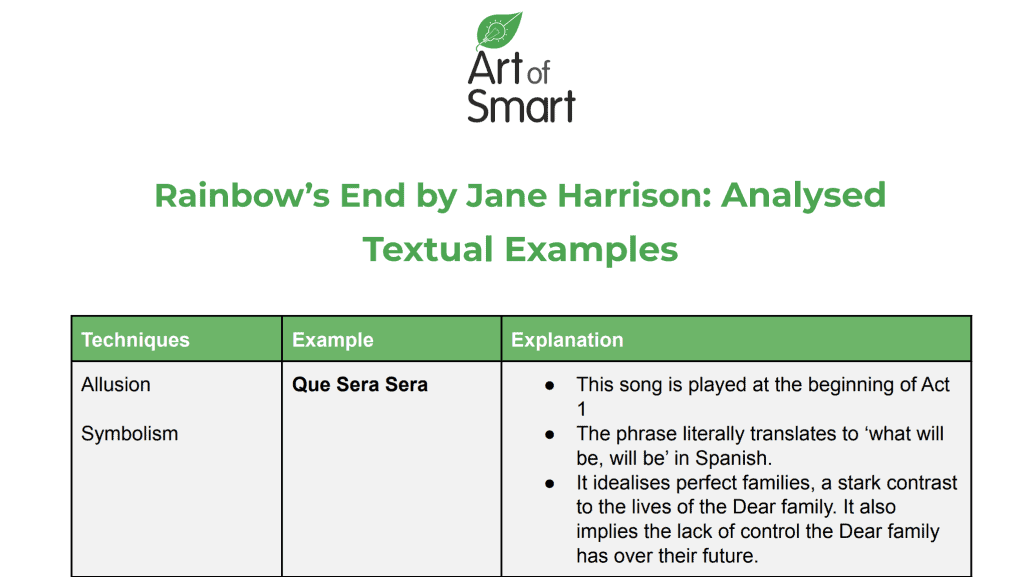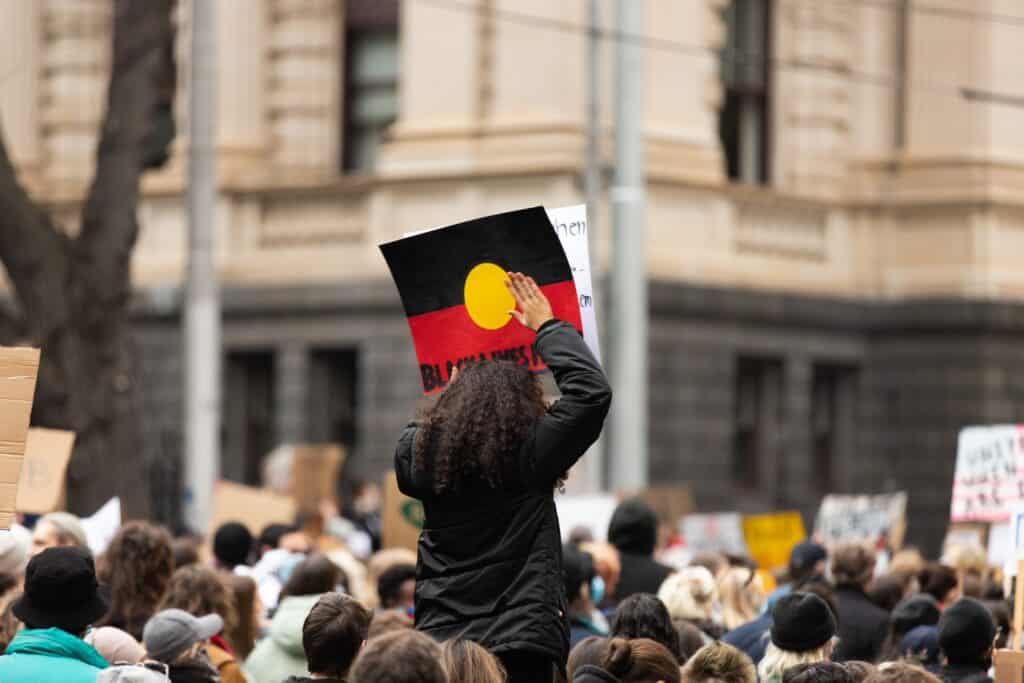If you have been tasked with an essay analysis on Rainbow’s End, look no further for we are here to give you a complete breakdown of the play, including a summary, characters, key themes and context.
In this article, you will also find tips on your Rainbow’s End analysis and even a sample paragraph and TEE table!
Let’s get right into it!
Rainbow’s End by Jane Harrison Summary
Key Characters in Rainbow’s End
Historical Context
Themes Explored in Rainbow’s End
Essay Analysis of Rainbow’s End
Rainbow’s End deals with language and content relating to racism and sexual assault. Please be advised that some of these quotes contain sensitive language that may be upsetting to some readers.
Rainbow’s End by Jane Harrison Summary
In summary, Rainbow’s End is set in the early nineteen fifties and follows the Victorian Koori historical story of the Dear Family, a First Nations family composed of Nan (grandmother), Gladys (mother) and Dolly (daughter).
From the first moment, the tight connections between the female leads are made obvious. With the men off and away at work, the women are bound by the events of the play and the family bond they share across three separate generations.
Near the rural town of Shepparton, Victoria, the Dear family lives next to an Aboriginal settlement in dilapidated housing called ‘The Flats’. Their home is separated from the settlement by a railway.
One day, Errol, a white salesman of encyclopaedias, mistakenly arrives and catches feelings for Dolly. She reciprocates via hints. Gladys subscribes to Errol’s services, which means he will return periodically to the family for the encyclopaedia collection.
After a while, Errol invites her to the local ball, where some of Dolly’s cousins will be attending the dance. Errol hopes then to confess his feelings to her.
Dolly is also nervous to attend as she cannot afford a dress on her own and shows up wearing a dress hastily made from house curtains. Some white attendees make fun of Dolly’s situation: seeing it as a cheap masquerade and humiliating her for wearing curtains.
After one of Dolly’s cousins tries to force himself on her and Errol defends her, Dolly has had enough of the night.
Errol confesses his feelings that night and tells her to leave everything behind and go with him to Melbourne. However, this means leaving her entire community and Dolly rejects this proposition. Outside the Ball, she is sexually assaulted by one of her cousins.
The Dear family is forced to evacuate the flats when a destructive flood occurs during the night. Dolly comes back to what is left of her home, telling Nan and the family of the assault.
Nan harbours suspicions against Errol due to the aggressive past of racism she had experienced. Dolly reveals it was actually one of her cousins and not Errol. The family relocates to Rumbalarra.
The recurring floods pushes the Aboriginal community to initiate protests against the government, demanding for better housing conditions. The movement grows, time passes, and we rejoin the action right when Dolly gives birth to her child.
The play ends on Gladys who delivers a powerful speech about housing conditions, Indigenous empowerment and rights.
In the final scene, Dolly grants Errol’s request to marry her, and Papa Dear comes back.
Key Characters in Rainbow’s End
Nan Dear
Nan Dear grew up during the White Australia policy and is a victim of the Stolen Generation.
She has experienced many encounters of racism, abuse and mistreatment from the white settlers. She was also sexually abused by one of the colonisers.
Due to the immense suffering she experiences, Nan Dear holds negative prejudices about Errol.
Gladys
As Dolly’s mother, Gladys is an exceptional parent to her daughter.
Her desires for her daughter’s future are a better education and access to more privileges in society than the 50’s Australian government would provide the Indigenous community.
She takes an interest in encyclopaedias and radio to educate Dolly. She is a fierce fighter, opposing the mistreatment and disenfranchised status of the Aboriginal population, wanting to fix things through advocacy and activism.
Dolly
As the principal protagonist of the story, Dolly represents the turn of the tides for Indigenous communities and a generation of Indigenous people with better opportunities.
Dolly represents the generation that demands better housing, education and an Indigenous way of life that is self-determined. She herself goes on a personal journey to understand what she desires in life, outside of the expectations of Nan Dear and her mother.
She finds her voice through the events of the play and realises her strength through actions such as her initial rejection of Errol’s proposition.
Errol
Errol is very similar to Dolly, a foil to her character in a way. He is open-minded and empathetic when Nan Dear mistrusts him.
Instead of being rageful, he proves himself to be the loyal and protective man Dolly needs.
Historical Context
The 1950s were an economically prosperous decade for Australia. The damage from WWII and the great depression meant things needed to be rebuilt around the world. However, the Indigenous world in the 50s was vastly different.
While a suburban way of life was projected and most non-Indigenous Australians were able to own their own homes for the first time, this new era only extended to the white working and middle class people in Australia.
Consider what Dolly’s and her family’s living situation. They live on the outskirts of town in a humpy. Rumbalarra, the town where Dolly’s family relocates to, was a flood-ridden area that lacked clean water and food — little had been done to rectifiy the situation until the 1970s when the Goulburn Murray Aboriginal Co-operative bought the area and improve it.
Indigenous Australians in 50s had to fight hard to sustain the richness of their life, and this resilience is shown throughout the play.
Themes Explored in Rainbow’s End
Empowerment and Control
In summary, the predominant narrative of Rainbow’s End portrays both the disparity and inequality with which First Nations people were treated in a white-dominant Australian society.
This is important to keep in mind, because these adverse conditions, prejudices and injustices not only serve as the main driver of action in the play, but also function as a theme, a critique of Australia’s society during the 1950’s economic boom.
This is the most important theme to identify in the play and you must address it in your essay one way or another!
Tip: Gladys’ speech at the end of the play also brings a nuanced and hopeful extension to this theme. It signals a step forward into giving Indigenous people the rights they deserve.
Marginalisation and Resentment
A subtle yet important theme to consider her in Rainbow’s End is that of resentment.
There are a few examples that you should take note of, the first of which being Nan Dear, who resents Errol. Such resentments were caused by Nan’ Dears experiences with the Stolen Generation policies and white colonialism.
We can also see this as a form of intergenerational trauma through Dolly. Dolly is subject to this dynamic too, as she refuses Errol for the first time out of societal fear of not fitting in the non-Indigenous white world.
This takes on a more complicated shade when Dolly is sexually assaulted by one of her Indigenous family members and reveals the intersection of Indigenous women’s experience — both cross-sectioned by race and gender.
Essay Analysis: How to Analyse Rainbow’s End in 3 Steps
Step 1: Choose Your Example
The best way to choose an example is to choose a technique.
Remember you must include stylistic devices (how images and words are arranged in a text in order to produce meaning) and aesthetic features (elements that prompt a critical response from the reader) in your essays to gain the most marks.
With Rainbow’s End, the script of the play offers little in terms of conventional literary techniques. However, you should consider the Indigenous slang and local vernacular that is embedded throughout the play.
You can also draw from dramatic and structural techniques used throughout the play!
Need a refresher on how to find and use quotes? Check out our guide!
Step 2: Identify Your Techniques
In this particular example, we will consider the theme of Empowerment and Control to comment on the play as a whole.
As evidence to show our opinion on this theme, we will use one of Gladys’ dream sequences in the play.
Step 3: Write Your Analysis
Always be ready to ask yourself what the author intended you to feel/respond emotionally by reading the example quote. This will make sure that you tackle an important part of the analysis, which is the effect on the reader:
Jane Harrison brilliantly utilises Gladys’ dream sequences as a vehicle to illustrate the disparity between the Indigenous and non-Indigenous world. Gladys’ dreams echoes throughout the play, wherein insight to her psychological thought fleshes out a compassionate anecdote to the poor housing situations of the 50s Victorian Koori community. While revealing how entangled her life is to fighting for equality, it also conveys the stark contrast between her dream for self-determination and reality.
And, that’s a wrap!
Check out other texts we’ve created guides for below:
- The Truman Show
- The Curious Incident of the Dog in the Night-Time
- I Felt A Funeral, in My Brain
- Journey of the Magi
- Frank Hurley: The Man Who Made History
- All the Light We Cannot See
- Lord of the Flies
- Hamlet
- Jane Eyre
- The Book Thief
- Things Fall Apart
- Mrs Dalloway
Reading this text for VCE English? Peruse our guide to the VCE English Study Design and build up your knowledge of the Framework of Ideas.
Are you looking for some extra help with your essay analysis of Rainbow’s End?
We have an incredible team of tutors and mentors!
We can help you master your essay analysis of Rainbow’s End by taking you through the summary, context, key characters and themes. We’ll also help you ace your upcoming English assessments with personalised lessons conducted one-on-one in your home or online!
We’ve supported over 8,000 students over the last 11 years, and on average our students score mark improvements of over 20%!
To find out more and get started with an inspirational tutor and mentor, get in touch today or give us a ring on 1300 267 888!
Vittorio Manessi is an Art of Smart tutor based in Queensland studying environmental science. He was one of the first Year 12 students to study under the new ATAR system in Queensland. He enjoys Maths, Science, English and Ancient History and is keen to share his knowledge of the QCE by making awesome resources.







